I thought I'd kick off the Allium 2011 topic, even though way too early for signs of plant growth outdoors. A NARGS member was inquiring about Allium tricoccum over on the Pacific Bulb Society mail list, so I'm jumping in with a photo of variegated forms of Allium tricoccum (Ramps) found by Darrell Probst in Massachusetts.
There's lots of interest in Ramps, including ramps festivals and dinners celebrating this pungent edible wildflower, so google to heart's delight to find out more, but here are a few links.
Ramps, the King of Stink:
http://www.kingofstink.com/
Connecticutt Wildflowers (the glossy round seeds are very attractive):
http://www.ct-botanical-society.org/galleries/alliumtric.html
nine photos here:
http://www.thismia.com/A/Allium_tricoccum.html


Comments
Trond Hoy
Re: Allium 2011
Sat, 02/19/2011 - 1:50pmIn Norway the counterpart is A ursinum called "ramsløk" (løk is equivalent to leek). "Ram" actually means strong smell as of a ram ;D
The plant is much used as a culinary herb (among certain people ;)
Todd Boland
Re: Allium 2011
Sun, 03/27/2011 - 3:32pmI've grown many alliums over the year but for some reason, despite many attempts, I cannot get the rampions (generic) to germinate. I am trying both species again this year. Both are still in strat.
Lori S. (not verified)
Re: Allium 2011
Sun, 03/27/2011 - 4:07pmThe birchbark makes a nice background to the photo, Mark!
Richard T. Rodich
Re: Allium 2011
Sun, 03/27/2011 - 4:14pmDitto on the birch bark.
I put the native Allium tricoccum seed I collected last year directly between moist paper towels at room temperature until mid-September. I think it was Deno, or perhaps someone else, that said the odd seed might germinate without a cold treatment. But there was no germination, and they still looked as healthy as can be. They have been in the fridge since then, and as of 2 days ago, they remain the status quo. I am very optimistic.
Mark McDonough
Re: Allium 2011
Sun, 03/27/2011 - 6:44pmI should have made it more clear that the photo of variegated Allium tricoccum is by Darrell Probst, not me, and it is indeed a clever on-the-fly way to get a good backdrop when photographing in the field.
Rick, I've only tried growing Allium tricoccum from seed a couple of times, and failed each time. I used to have one bulb that would flower every year, never increased in a decade or more, probably too dry where it is, and now I'm not sure if it is still there, the wild woody area where it is growing remains an absolute mess of fallen splintered tree limbs from the ice storm of December 2008 and I've not bothered to tidy up that wild part of the yard yet, a formidable amount of work.
Richard T. Rodich
Re: Allium 2011
Sun, 03/27/2011 - 7:42pmThe best Allium tricoccum I have found in the wild (and I haven't observed that many - 25?) have always been on an east facing gentle slope, and the best of those on the east side of fallen maple trunks that are just up hill (to the west) that give it extra protection from late day heat.
And ditto for [i]Decentra canadensis[i].
Leonard Lehman (not verified)
Re: Allium 2011
Mon, 03/28/2011 - 7:39amAs relatively new viewer, I am very interested in the Allium discussions. I have planted seed of several Alliums from the NARGS seed exchange and many are now emerging in my area. One species I can not find much info on is Allium vavillovii. I would greatly appreciate an cultural or links where I can find more about this intrigueing species.
Len Lehman
PS Our local Alleghany chapter of NARGs will be hosting the Eastern Study weekend in Oct. 12-14th, 2012 near Pittsburgh. Matt Mattus is scheduled to give a talk on Fall Blooming bulbs. Hope you all would consider coming as we will be at peak fall foliage color and have several great field trips planned for the event.
Mark McDonough
Re: Allium 2011
Mon, 03/28/2011 - 10:23amHello Len, welcome to the NARGS Forum, thanks for making the onion pages your first stop ;) It is early for alliums, looking forward to the spring season advancing to start seeing some onion greenery. The information on the Eastern Study weekend in Oct. 12-14th, 2012 near Pittsburgh sounds good, I'd like to make it to that one. I hope to make it out to a Berkshire Chapter NARGS meeting this weekend (April 2nd), where our local Massachusetts native Matt Mattus is speaking.
Regarding Allium vavilovii, this is the species thought to be the ancient wild ancestor of the vegetable onion, or Allium cepa. Onions (A. cepa) have been cultivated for thousands of years, and as such, is not known from the wild, but is thought to have derived from early introduction of closely allied species centuries ago, namely A. vavilovii from Afghanistan, Tajikistan, Uzbekistan, and Turkmenistan, or possibly A. oschaninii (from the same geographical area). It is indeed hard to find much information on these, at least in the ornamental horticultural realm, because they are mostly studied in scientific terms as an agricultural crop. Appearance-wise, it will look very similar to regular onions or A. cepa, having hollow inflated leaves, and dense ball-like heads of whitish flowers. Personally I have not grown this species, although have tried a few ornamental sorts that are closely allied, such as A. pskemense, which is indeed weirdly ornamental and a cool plant.
An excellent resource for alliums is the Taxonomic Allium Reference Collection, hosted at the Institute of Plant Genetics in Gatersleben, Germany. See the link below, from the Allium 2010 topic, with some tips on how to use and navigate this database.
http://nargs.org/smf/index.php?topic=177.msg4950#msg4950
Allium vavilovii, in the Taxonomic Allium Reference Collection, has 4 records... the last record has two images of A. vavilovii.
(tip: click on the little paper icon on the left of a record, then use right or left arrow keys to move through the records... if a record has thumbnail images, click on them to enlarge the image)
http://pgrc-35.ipk-gatersleben.de/pls/htmldb_pgrc/f?p=265:3:248087226952...
Abstract on a recent paper on A. vavilovii and a new Iranian species, A. asarense:
Full paper is $34, rather annoying, considering most of what is on the web is free. If you're interested in that paper, I can ask the author (Dr. Reinhard Fritsch) if he can share a copy.
"Allium vavilovii M. Popov et Vved. and a new Iranian species are the closest among the known relatives of the common onion A. cepa L. (Alliaceae)"
http://www.springerlink.com/content/p8m2p755t361417p/
photo of a blooming plant in a garden setting:
http://www.alltomtradgard.se/_internal/cimg!0/69bu796aq6gm68xjw7jw9napkv8x4zp
...inflated leaves:
http://www.alltomtradgard.se/_internal/cimg!0/4gnvk2q1hxv1ho7hskwajmpwn8srk6d
Richard T. Rodich
Re: Allium 2011
Mon, 03/28/2011 - 5:04pmWow, I am very surprised how close the species looks to our present vegetable onion. I think I would get a lot of funny looks from visiting gardeners if I grew that. On the other hand, they would be just as surprised as me!
Hi Len. Glad you stopped in! There's always good, informative allium talk here with the Onion Man (Mark).
Stephen Barstow
Re: Allium 2011
Tue, 03/29/2011 - 12:44amMy first post, having lurked in the undergrowth for some time!
Hello Hoy! I believe I'm one of those "certain people" and proud of it! :)
Mark: You knew how to entice me out of the bushes, didn't you - posting some pictures of some tasty smelly variegated onions - my favourite subject!
Re- Allium tricoccum germination - my experience that it typically takes 2 years before they start popping up, so patience is important! Haven't had a lot of success with them over here in Norway. Most have simply disappeared (only one has survived for several years but doesn't get any bigger). I planted another batch last year, so I haven't given up yet. I wonder if our summers are too cool and wet (but I note Mark’s comment of dryness also being a problem – narrow ecological requirements it seems? – this is a species that has a summer rest. Haven’t seen it elsewhere in Europe apart from in Kew Gardens, which makes me suspect it is difficult. It’s also not listed by the comprehensive RHS Plant Finder (http://apps.rhs.org.uk/rhsplantfinder). I rembering reading some time ago. As I’ve understood it ramsons (ursinum) and ramps (tricoccum) are only distant relatives Allium-wise, despite the resemblance. I’ve only once tried to germinate ursinum – I received a Russian “cultivated” form (from the Caucasus), but it didn’t germinate. I live near the world’s most northern ursinum site – a place called “Ramslia”!
Re- Allium vavilovii: I had seed of this early 2000s and I decided that the plant that materialized was nothing more than fistulosum and removed it (perhaps I was wrong!). Received more seed (from Sweden) in 2007, but those plants died in a very cold winter. Planted a new one from the same batch last year, so I hope I’ll have a chance to study it more closely next summer.
P.S: My avatar is a salad with Allium ursinum flowers (Yes, I agree – an improvement on my SRGC avatar).
Mark McDonough
Re: Allium 2011
Tue, 03/29/2011 - 4:30amA hearty welcome to the NARGS Forum Stephen; I was hoping you'd find you way over here to our little onion patch. ;D
Regarding ramps (A. tricoccum), I don't think I'm trying hard enough, just allowing a single bulb to languish unattended for a decade under the bone dry shade of sugar maple trees; not a fair assessment of its fitness for the garden. The species is native here in Massachusetts and nearly the entire eastern half of North America, so surely it can't be that hard to grow, more a matter of finding the right sort of spot for it; probably needing humus-rich soil, reasonable spring moisture, and a summer rest. Good to know seed might require 2 years to germinate, I may have given up on ungerminated seed pots too soon.
On A. vavilovii, the paucity of verifiable images of this species is testament to the fact the true species is rare in ornamental horticulture, usually replaced by one of the more common onions in Section Cepa, such as A. fistulosum, or A. cepa itself.
Stephen, after my 40+ years of cultivating N. American alliums like A. cernuum and A. stellatum, you have inspired me to actually try eating some this year; my wife is doing up some good stir-fry these days, and I imagine the blood red bulb-coat forms of A. cernuum would be visually pleasing and tasty too.
Stephen Barstow
Re: Allium 2011
Tue, 03/29/2011 - 5:08amThanks for the welcome, Mark.
Good to hear that you're now using as well as knowing your onions! I've always thought that The Onion Man need never go hungry (even if times get really bad)! What inspired me to try Allium cernuum years ago was getting a copy of Sturtevant’s Edible Plants of the World (in Seattle) and reading that Allium cernuum and A. canadense had formed almost the entire source of food to the French Missionary (Jacques) Marquette and his party from Green Bay to the present site of Chicago in 1674! Fittingly, there’s a park in Chicago called Marquette Park (named after Pere Marquette) and a remnant of the original prairie on which Chicago was built and thrives there thanks to volunteers, with Allium cernuum one of the original plants…..Of course, Chicago simply means onion, so if you fancy a change you could just call yourself The Chicago Man! Link to the Sturtevant text: http://www.henriettesherbal.com/eclectic/sturtevant/allium.html
Richard T. Rodich
Re: Allium 2011
Tue, 03/29/2011 - 8:48amHello, Stephen! That's a very colorful and scrumptious looking salad. I wonder if you are the first to have food as an avatar...
Care to elaborate on its ingredients? Do I see daylily flowers?
I have eaten Allium stellatum (bulbs), the more common native onion species here in Minnesota. The species (and A. cernuum) were eaten by all the Native American tribes that lived here. I wonder if there is a difference, tastily speaking, between stellatum and cernuum. Have you tried them both, Stephen?
About ramps (Allium tricoccum), "fresh seed have an underdeveloped embryo that must develop before the cold period.Late summer/early fall planting should be enough."
Cultivation of ramps-Jackie Greenfield&Jeanine Davis, NCSU
http://www.ces.ncsu.edu/depts/hort/hil/hil-133.html
The origin of the name "Chicago" is Native American, and is thought to refer to A. tricoccum, the "smelly onion" that was abundant there.
The few wild ramps that reside close to me are in maple/oak forest, and in areas that definitely go dry in summer. In fact, they sit up on a hill adjacent to a small lake, not down near the bottom where it is more moist all season.
Stephen Barstow
Re: Allium 2011
Tue, 03/29/2011 - 9:27amHello Rick!
The salad (you did ask!): one of my less diverse efforts with a mere 77 varieties (and 61 species). The flowers were:
Alliaria petiolata
Allium cernuum “Pink Giant”
Allium schoenoprasum “Pink Flowered"
Allium schoenoprasum “Wallington White”
Allium schoenoprasum ssp. sibiricum
Allium ursinum
Campanula latifolia
Cardamine pratensis
Crambe maritima
Hemerocallis lilioasphodelus
Hemerocallis middendorfii
Myrrhis odorata
Osmorhiza claytonii
Osmorhiza longistylis
Rubus x (R.a arcticus x stellatus);
Taraxacum officinale "Pissenlit Coeur Plein Ameliore"
Viola x wittrockiana "Black Princess"
Wasabi japonica; Wasabi
(You can see cooked ostrich fern too)
Stellatum: I’ve grown an imposter for many years. Hopefully I will have the real thing this year, thanks to Mark (I think)....
Tricoccum: That makes sense as I have usually been sent seed mid-winter, so wouldn’t germinate until the second year.
Chicago: I’d heard of various candidate species: cernuum, canadense and tricoccum. However, this article seems to suggest we’re both wrong (can’t see the end of the article thought): http://www.jstor.org/pss/40192527Haven’t time to check more.... Anyone know what current thinking is?
Trond Hoy
Re: Allium 2011
Tue, 03/29/2011 - 2:02pmDon't you have a word for birchbark? In Norwegian it is called "never" ;D and was used for many things, roofs, cups, boxes etc.
Trond Hoy
Re: Allium 2011
Tue, 03/29/2011 - 2:05pmStephen it is not you first but second post! And I knew you eat such green stuff ;D I do it myself; every year I get a present from a lady I know and that is Allium ursinum butter!
Richard T. Rodich
Re: Allium 2011
Tue, 03/29/2011 - 2:49pmAn epicurean's delight!
And not boring at all!
(I wonder if Wim's R. ficaria 'Salad Bowl' - wait, just read your other post: not the flowers!)
Stephen Barstow
Re: Allium 2011
Wed, 03/30/2011 - 12:24am...don't forget it was used for bread (the inner bark at least) :)
LucS (not verified)
Re: Allium 2011
Sun, 04/10/2011 - 1:00pmThe allium season has started with a few species from the acanthoprason section:
Allium breviscapum
Allium haemanthoides
LucS (not verified)
Re: Allium 2011
Sun, 04/10/2011 - 1:03pmMark, you know I have now and then an allium species without ID.
What do you think of this one ?
LucS (not verified)
Re: Allium 2011
Mon, 04/11/2011 - 10:20amAnother one is the Iranian Allium elburzense. These are seed-raised why a little variation in colour is possible.
LucS (not verified)
Re: Allium 2011
Mon, 04/11/2011 - 10:24amAllium noeanum, another Iranian species.
Mark McDonough
Re: Allium 2011
Mon, 04/11/2011 - 6:05pmLuc, all those onions are fantastic, pure alliaceous delight! :o :o :o
I'm always amazed by how many desirable Central Asian species there are, but so darned few in general cultivation. I wonder why that is? Do these make viable seed for you? Your first photo of the potful of A. elburzense shows more than just a little variation, a most educational look at just how variable plants can be from a seed lot... I like em all. Before you followed with photos of A. elburzense, I was going to suggest that your unknown Allium from Ahar-Tabriz (Iran) looks like A. elburzense, in fact, I still think so.
The long narrow-tepaled A. breviscapum and wide-headed A. noeanum are also rock garden gems, thanks for potraying these beauties with such fine photos.
I sowed a bunch of Allium seed last year and the year before, directly out in the garden in marked locations, of various Pilous seed and some K.Vickery seed. Checking them this past weekend, most show germination and a few showing small 2nd year leaves. Also in summer of 2010, I received seed of dozens of Allium species from Kazakhstan; many are showing strong germination this past weekend as well. I plan on showing photos in 5-6 years ;D
Mark McDonough
Re: Allium 2011
Sun, 04/17/2011 - 10:00pmA miscellany of Alliums come to mind as the season starts up.
Allium victorialis is surging into growth. I grow three forms, an unnamed type, and two cultivars, A. victorialis 'Cantabria' (upright growing but more slender and smaller growing than the next) and A. victorialis 'Kemerovo' with is a large-growing upright form with beautiful fresh pleated leaves in spring.
A. victorialis 'Cantabria' left, 'Kemerovo' on the right.
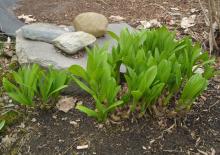
A. victorialis - closeup views showing the burlap-like reticulated bulb coats; the bulbs sitting at and above the soil level.
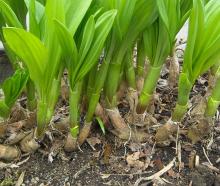
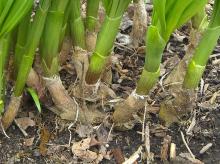
A. victorialis 'Kemerovo' - lush foliage emergence
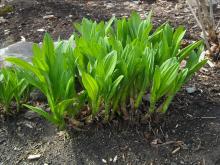
Allium nutans - variegated. I received seedlings from Jim Jones in my hometown of Lexington Massachusetts, of a variegated form of Allium nutans. The seedlings varied from all green, to those showing some variegation, to one that was strongly white-leaved with green stripes. The latter eventually died, but here's a view of a strong growing one that shows some good variegation. The flowers are pale lilac and not so good, a work in progress.
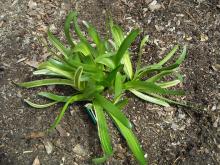
Allium schoenoprasum 'Curly Mauve' is one of my selections; I really like the strongly prostrate curling spring growth. On the right you can see a seedling plant that is larger in growth... tending towards the same prostrate foliage emergence.
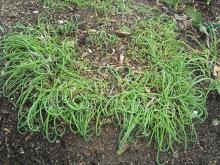
Allium species received as A. altissimum from Arnis Seisums, E Kopet-Dag, Turkmenistan, the giant of the genus growing to 5-1/2' tall. Dr. Reinhard Fritsch believes it is actually A. stipitatum. Either way, it is a highly ornamental tall allium that is a good doer in the garden, the photo showing that the bulbs split and increase; I really should dig it up and separate the bulbs this summer. I like the look of the emerging shoots.
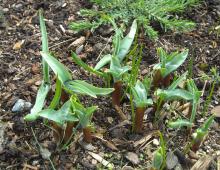
Stephen Barstow
Re: Allium 2011
Tue, 04/19/2011 - 6:02amJust like to say that that I really enjoyed your NARGS article, Mark ....bedtime reading the last few nights! Particularly like Green Eyes and Wall of Pink....just wish they were available over here... Same applies to Curly Mauve (above). Victorialis is also a favourite and I'll post something about that one soon myself. If you ever get seed off that variegated nutans, would love to try it... :)
Here's one of my spring favourites, Asian Allium carolinianum photographed a couple of days ago:
John P. Weiser
Re: Allium 2011
Tue, 04/19/2011 - 11:06amMark
How many species of allium do you grow? The list seems endless.
I'll have to think twice, before asking how many varieties and hybrids there are.
Stephen Barstow
Re: Allium 2011
Wed, 04/20/2011 - 11:06amAre your Cantabria and Kemerovo reversed? The picture further down should be Kemerovo if it's right?
Stephen Barstow
Re: Allium 2011
Wed, 04/20/2011 - 11:12amThought I'd show you my Victory Onions as they are today. I have about 10 different accessions, but most are still small. Here's a picture of each of the ones that are a decent size:
1) Received as var platyphyllum (from Japan) - very early and much further advanced than the other two.
2) Allium ochotense (synonym) also from Asia
3) Allium victorialis (Norwegian naturalised population from the Lofoten Islands)
I've notice also that an accession from Kola (NW Arctic Russia) is also way ahead of the others.
LucS (not verified)
Re: Allium 2011
Fri, 04/22/2011 - 9:46amTwo more alliums from Iran:
Allium colchicifolium
Allium materculae ssp. materculae var. albiflorum
McGregorUS (not verified)
Re: Allium 2011
Sat, 04/23/2011 - 5:59amLove the Iranian Alliums Luc - they seem a distinctive bunch. Allium breviscapum is such a looker! I'm just getting into Alliums after editing Mark's first (and upcoming second article for the Quarterly). So my main choice from the seed exchange had some alliums and now the ones from the surplus seed ex as well. Have to go and see what is happening - been away at the International Rock Garden Conference and then had a visitor so only just getting straight.
Mark McDonough
Re: Allium 2011
Sat, 04/23/2011 - 7:08amCatching up here :-\
Thanks for your comments Stephen. I need to get Green Eyes, Wall of Pink, and a few others into the hands of nurserymen, to start making these available. Love the look of emerging shoots of A. carolinianum, nice picture, and an excellent clump of this beautiful species. I used to grow about 5-6 forms of this; I'm down to one form that persists and flowers about 1 out of every 3 years, and it never increases. Among some of the forms that I lost, where much easier and better growers, although that didn't help them when I allowed my garden to go wild with weeds for too many years when my two daughters were young and lack of time got the better of me.
Seed of Curly Mauve will yield plants that are variably curly, most not as prostrate as the original, but some interesting curly-whirly plants should result... I'll be sure to collect seed this year.
I have a particularly robust form of Allium hymenorrhizum (closely allied to A. carolinianum) that has similar thick ruddy red shoots in spring. Here are two views of emerging shoots from some years back, the plant is still with me and a good grower, although it makes very little seed, none in some years.
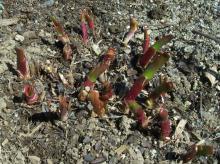
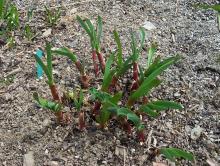
Allium hymenorrhizum robust form, at latter leaf growth, showing mildly falcate leaves, which is somewhet unusual for the species:
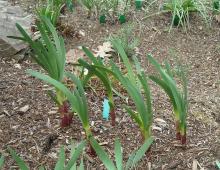
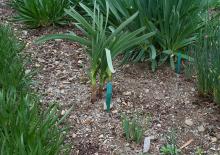
And a view of the emerging shoots on my Allium carolinianum back in 2001. In the 10 years since, it has not increased, and is still just two shoots :rolleyes: In 2009, it was one of the rare years where it condescended to flower. I have seen photos of spectacular forms of this species, my plant is not among them.
Mark McDonough
Re: Allium 2011
Sat, 04/23/2011 - 7:27amJohn, I used to grow approximately 130 species + many forms of certain species. That count has paired back quite a bit through the years, although offset by a large increase in hybrids, so there are still lots of alliums here to pique my interest. Sowing seed of some of the Iranian and Central Asian species starting a couple years back, and with many accessions from Kazakhstan last year (most have germinated), the numbers will hopefully increase, although it's a slow proposition with many of them, requiring 5-6 or more years from seed.
For example, here is a photo (left) of some seedlings of A. shelkovnikovi, one of those dwarf C. Asian species with a ball of bloom just above wide leaves. I sow my seed outside directly in the garden, marked with minimum of two labels. In this view, you can see a couple fresh seedlings that just emerged a couple weeks ago, and a couple 2-year seedlings where the young immature leaves are starting to take on the gray curled leaf characteristics. This was seed from Kurt Vickery. The center photo shows a similar situation, with in-situ seedlings of Allium aff. elburzense (K.Vickery again), lots of fresh germination this year (2nd year germination) and a couple of silvery 2-year leaf sprouts fro germination last year.
Photo on the right shows fresh germination from Allium sp. coll. N. Sivas, Turkey, from NARGS Seed Exchange 2008-2009, which has only just germinated. Folks, don't give up on those old seed sowings, you never know, one can still get good germination after 2 years! Hooray!
Will catch up with other posts later.
Richard T. Rodich
Re: Allium 2011
Sat, 04/23/2011 - 6:46pm...and I learned (in school?) that onion seed (Allium cepa) lost its viability rather quickly, that in practical terms it's not worth sowing seed more than a year old. Is this only for the vegetable onion? Only for dry seed? Maybe moist storage prolongs viability? Or maybe I'm just . . . . wrong?
Mark McDonough
Re: Allium 2011
Sat, 04/23/2011 - 8:07pmI have no experience with A. cepa seed, but I can vouch for relatively long viability of Allium seed for several years, particularly those species with larger thick seed, or round pellet-like seed, versus those with flatter flake-like seed. I find that 2nd year germination is quite common on certain types of Alliums species, such as those in the Melanocrommyum section (a la Allium giganteum types).
Stephen Barstow
Re: Allium 2011
Sun, 04/24/2011 - 12:57amMy experience is that seed of Allium cepa and fistulosum vegetable cultivars remains viable for 2-3 years, longer than the oft-quoted 1 year, at least under my storage conditions (cool cellar - 2-3C in winter and maybe up to 15C in summer).
Stephen Barstow
Re: Allium 2011
Sun, 04/24/2011 - 1:30amHere's my carolinianum in flower last summer! However, I've seen a significantly larger, more vigorous plant in the botanical gardens in Tromsø in Northern Norway, it seems to like cool conditions.
Stephen Barstow
Re: Allium 2011
Sun, 04/24/2011 - 1:36amLike the Allium hymenorrhizum pictures. I have plants from 2 or 3 sources and none look at all like carolinianum. I have pictures of this species in both the Oxford and Copenhagen Botanical Gardens and I see that both look wrong!
Stephen Barstow
Re: Allium 2011
Wed, 04/27/2011 - 12:25pmMark - I notice that all of your victorialis seem to have green rather than red bases. Is that correct? All of mine have red bases apart from Cantabria (that includes the Norwegian material, plants from the Kola Peninsular (NW Russia) and Asia (received as A. ochotense and ssp platyphyllum). Do you know if you find both green and red forms in the same populations?
Tony Willis (not verified)
Re: Allium 2011
Thu, 04/28/2011 - 4:56amtwo forms of
Allium akaka from Eastern Turkey
WimB (not verified)
Re: Allium 2011
Tue, 05/03/2011 - 5:38amSome Alliums flowering here now:
Allium akaka
Allium litvinovii
Allium nevskianum
Allium platycaule
and an Allium which was hiding in the packet of A. platycaule; which it clearly is not! Maybe A. akaka??
Stephen Barstow
Re: Allium 2011
Thu, 05/12/2011 - 1:19amMore great Alliums Wim and Tony!
A couple of years ago I toured Northern Norway early June and a lovely white flowered Allium I hadn't seen before was in full bloom and I was told it was Allium humile. I can't find much reference to it on SRGC or here as it's such a lovely floriferous plant. It is very early (only paradoxum beats it here) and is a few days earlier than zebdanense. I was given a plant and it flowered here for the first time:
1) Picture taken in Tromsø, Northern Norway
2) I wondered what it was when i saw it in bud (I didn't immediately think Allium)
3-4) In flower last night
Trond Hoy
Re: Allium 2011
Thu, 05/12/2011 - 3:52amBeautiful Allium, Stephen! I regret I didn't ask for a bulb when I visited you ;D I will next time ;)
Stephen Barstow
Re: Allium 2011
Tue, 05/31/2011 - 2:58amLast week I had several Allium experiences which I'd like to share with you. I've had a project the last 3 years for the Norwegian Genetic Resource Centre collecting old perennial edible onions from old gardens and mostly old people across Norway (mostly Allium x proliferum, Allium fistulosum, A. schoenoprasum, A. scorodoprasum and A. victorialis, about 11 species in total and well over 100 accessions). I'm currently growing them out in my garden so that we can compare the different accessions. Anyway I had to give a presentation of the project at a seminar in Southern Sweden. On the way home, I visited the Copenhagen (Denmark) and Gøteborg (Gothenburg) botanical gardens and took a lot of Allium (and other) pictures. In particular, Gothenburg has an amazing collection of plants and I could easily spend a couple of days there.
Gøteborg has an fantastic bulb garden with many Alliums in honour of Per Wendelbo (1927-1981) who was a botanist and professor at the garden, specialising in Himalayan plants and many of the plants in the garden were collected by him. Here is a selection (see the file names for the plant names):
Stephen Barstow
Re: Allium 2011
Tue, 05/31/2011 - 3:00amThe last batch from the Wendelbo garden, more from the open garden later. Let me know if you see any mistakes!
Trond Hoy
Re: Allium 2011
Tue, 05/31/2011 - 3:55amYou have to mention, Stephen, that Per was a Norwegian (and I thought that he was an expert of bulbs from Iran (he also worked at the botanical garden in Teheran) and surrounding countries). He died 1981 in a car accident when he should start his work in Bergen.
Marvellous bulbs you show, anyway!
Stephen Barstow
Re: Allium 2011
Tue, 05/31/2011 - 4:17amYes, I thought he was Norwegian, but there is no mention of this important fact on the Swedish sign and I didn't find anything on his wikipedia page (very short), so I didn't mention it....
On the Norwegian wikipedia page, http://no.wikipedia.org/wiki/Per_Wendelbo you will see that the page is classified under Swedish Botanists....
By the way, the sign mentions that the garden contains some 1,600 accessions!
Trond Hoy
Re: Allium 2011
Tue, 05/31/2011 - 12:53pmBetter with this one then ;D
http://www.snl.no/.nbl_biografi/Per_Wendelbo/utdypning_%E2%80%93_1
Stephen Barstow
Re: Allium 2011
Tue, 05/31/2011 - 1:29pmExcellent, takk!
Mark McDonough
Re: Allium 2011
Tue, 05/31/2011 - 7:17pmI have much to catch up on, and lots of Allium pics besides... still sidelined by a deadline for work, will try to catch up in a few days.
Stephen Barstow
Re: Allium 2011
Wed, 06/01/2011 - 1:35amIn the meantime, as I was wandering around the garden, it seemed that you were with me, Mark. See the following set of images (none of the plants were in flower, so I won't bore you with pictures of greens):
Pages